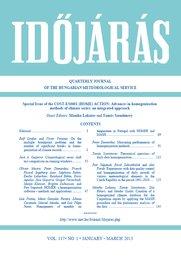Időjárás - Quarterly Journal of the Hungarian Meteorological Service (OMSZ)
Vol. 117, No. 1 * Pages 1–158 * January - March 2013
Editorial
Mónika Lakatos and Tamás Szentimrey
idojaras.2013.1.1
Mónika Lakatos and Tamás Szentimrey
idojaras.2013.1.1
On the multiple breakpoint problem and the number of significant breaks in homogenization of climate records
Ralf Lindau and Victor Venema
idojaras.2013.1.2 (p. 1–)
Ralf Lindau and Victor Venema
idojaras.2013.1.2 (p. 1–)
Climatological series shift test comparison on running windows
José A. Guijarro
idojaras.2013.1.3 (p. 35–)
José A. Guijarro
idojaras.2013.1.3 (p. 35–)
HOMER : a homogenization software – methods and applications
Olivier Mestre, Peter Domonkos, Franck Picard, Ingeborg Auer, Stéphane Robin, Emilie Lebarbier, Reinhard Böhm, Enric Aguilar, Jose Guijarro, Gregor Vertachnik, Matija Klancar, Brigitte Dubuisson, and Petr Stepanek
idojaras.2013.1.4 (p. 47–)
Olivier Mestre, Peter Domonkos, Franck Picard, Ingeborg Auer, Stéphane Robin, Emilie Lebarbier, Reinhard Böhm, Enric Aguilar, Jose Guijarro, Gregor Vertachnik, Matija Klancar, Brigitte Dubuisson, and Petr Stepanek
idojaras.2013.1.4 (p. 47–)
Homogenity of monthly air temperature in Portugal with HOMER and MASH
Luís Freitas, Mário Gonzalez Pereira, Liliana Caramelo, Manuel Mendes, and Luís Filipe Nunes
idojaras.2013.1.5 (p. 69–)
Luís Freitas, Mário Gonzalez Pereira, Liliana Caramelo, Manuel Mendes, and Luís Filipe Nunes
idojaras.2013.1.5 (p. 69–)
Measuring performances of homogenization methods
Peter Domonkos
idojaras.2013.1.6 (p. 91–)
Peter Domonkos
idojaras.2013.1.6 (p. 91–)
Theoretical questions of daily data homogenization
Tamás Szentimrey
idojaras.2013.1.7 (p. 113–)
Tamás Szentimrey
idojaras.2013.1.7 (p. 113–)
Experiences with data quality control and homogenization of daily records of various meteorological elements in the Czech Republic in the period 1961–2010
Petr Štěpánek, Pavel Zahradníček and Aleš Farda
idojaras.2013.1.8 (p. 123–)
Petr Štěpánek, Pavel Zahradníček and Aleš Farda
idojaras.2013.1.8 (p. 123–)
Creation of a homogenized climate database for the Carpathian region by applying the MASH procedure and the preliminary analysis of the data
Mónika Lakatos, Tamás Szentimrey, Zita Bihari, and Sándor Szalai
idojaras.2013.1.9 (p. 143–)
Mónika Lakatos, Tamás Szentimrey, Zita Bihari, and Sándor Szalai
idojaras.2013.1.9 (p. 143–)
IDŐJÁRÁS - Quarterly Journal

Az IDŐJÁRÁS a HungaroMet Nonprofit Zrt. negyedévenként megjelenő angol nyelvű folyóirata
Megrendelhető a journal.idojaras@met.hu címen.
A szerzőknek szánt útmutató itt olvasható.
Megrendelhető a journal.idojaras@met.hu címen.
A szerzőknek szánt útmutató itt olvasható.










